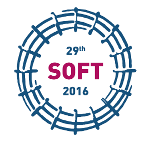Speaker
Dirk Pilopp
(E4)
Description
WENDELSTEIN 7-X (W7-X) is a superconducting helical advanced stellarator which is currently in operation phase 1.1 at the Max-Planck-Institut für Plasmaphysik in Greifswald.
During this startup period five uncooled inboard poloidal limiter structures made from fine corn graphite protect the plasma vessel wall, since the divertor, heat shields and carbon tiles are not installed yet. At 10 ports immersion tubes carrying each a set of two magnetic-field hardened cameras detecting light in the visible spectral range (VIS) and one near infrared camera (NIR) to observe the unshielded divertor-mounting components and the limiter structure. The two VIS-cameras are equipped with interference filters registering plasma radiation in particular spectral ranges of Ha, CII or CIII light to extract spatially-resolved information on particle flux and carbon production. Certain VIS-cameras are operated without filter with ultra-wide field of view objectives as video surveillance. The NIR lenses are surrounded with a ring of optical fibres for in-vessel illumination for inspection purposes. A rotating shutter protects the glasses from deposition and erosion.
Further 10 overview video cameras are observing at tangential ports the plasma vessel interior for spatial and temporal inspection in the visible spectral range. Highly sensitive CMOS cameras have been applied to detect the vacuum magnetic flux surfaces during the commissioning of the device. Additionally a fast camera is setup at one port to detect fast events and plasma fluctuations.
The presentation will give an overview of the observation systems and show first results obtained during the first operation phase.
Co-authors
Christoph Biedermann
(E4, Max-Planck-Institut Plasmaphysik, Greifswald, Germany)
Dirk Pilopp
(E4, Max-Planck-Institut Plasmaphysik, Greifswald, Germany)
Gabor Koscis
(RCP RMO, Wigner Institut, Budapest, Hungary)
Ralph Konig
(E4, Max-Planck-Institut Plasmaphysik, Greifswald, Germany)
Tamas Szepesi
(RCP RMO, Wigner Institut, Budapest, Hungary)
Thomas Sunn Pedersen
(E4, Max-Planck-Institut Plasmaphysik, Greifswald, Germany)

